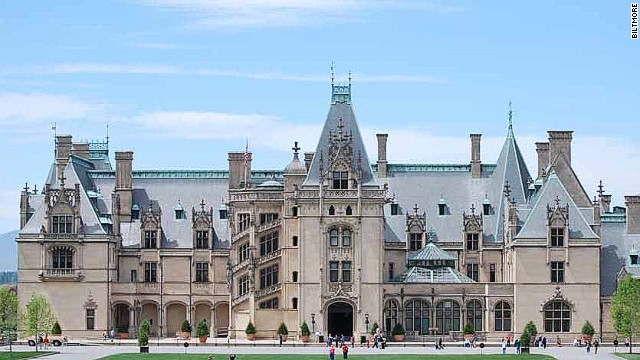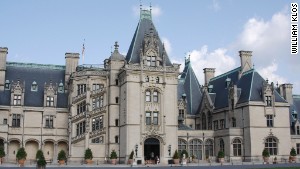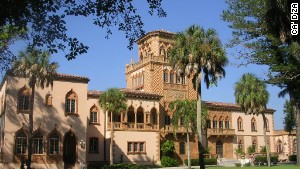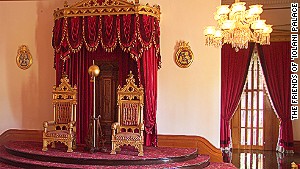By Jordan Rane, for CNN
updated 5:51 AM EDT, Mon August 26, 2013
 The largest privately owned
residence in the United States has 250 rooms, 43 bathrooms, 65
fireplaces, three kitchens and, in case any French diplomats drop by,
Napoleon's old chess set.
The largest privately owned
residence in the United States has 250 rooms, 43 bathrooms, 65
fireplaces, three kitchens and, in case any French diplomats drop by,
Napoleon's old chess set.
Biltmore (Asheville, North Carolina)
STORY HIGHLIGHTS
- The U.S. is home to a melting pot of "royal" domiciles
- All these palatial estates are open to the public
- Edsel Ford's home is a 60-room, 20,000-square-foot masterpiece on Michigan's Gold Coast
- 'Iolani Palace is the only former official residence of a reigning monarch on U.S. soil
(CNN) -- For a country that ditched monarchical rule, America has some of the most intriguing "castles" in the world.
OK, maybe not castles in the classic sense.
To visit a fortress where
ancient monarchs slept on stone pillows and knights bickered about
grails, you'll still have to fly across the pond.
But for a different sort
of castle -- the kind redefined by Gilded Age names such as Vanderbilt
and Ringling, by proud Polynesian monarchs or by the occasional
heartbroken Latvian-Floridian stonemason -- the United States is home to
a melting pot of historic domiciles that would blow an 11th-century
Scottish king's mind.
Here we crown seven favorites whose gates are open to gaping plebeians.
King of Cottages: The Breakers (Newport, Rhode Island)
Story: In 1893 Cornelius
Vanderbilt II, heir to the New York Central Railroad, commissioned
Richard Morris Hunt to design this palatial summer home inspired by
16th-century Genoan palazzos.
The largest and grandest
of Newport's famous "cottages" (colossal leisure homes erected by
America's turn-of-the-century baron class), the Breakers was created in
just a few years by a team of 2,500 craftsmen from around the world.
Specs: Located on a
13-acre cliff-side estate overlooking the Atlantic Ocean, the 70-room
house covers 126,000 square feet from attic to basement to mezzanine.
Standout rooms include a
22-carat gold-leaf-adorned Great Hall stretching 50 feet in every
direction (including overhead) and a two-story, alabaster-columned
dining room featuring enormous Baccarat crystal chandeliers and a table
for 32.
Stopping by: Now in the
hands of the Preservation Society of Newport County, the Breakers is one
of the five most-visited homes in the country. One-hour audio tours
cover about 20 rooms on the first and second floors.
The Breakers, 424 Bellevue Ave., Newport, Rhode Island; +1 401 847 1000; admission $19.50
Biltmore: ultimate expression of sibling rivalry
Little Brother Complex: Biltmore (Asheville, North Carolina)
Story: George Washington
Vanderbilt II clearly had bigger ideas than simply one-upping older
sibling Cornelius (of the Breakers) with this massive, 1890s French
chateau plunked on the edge of North Carolina's Smoky Mountains.
But when you use the
same architect to dwarf your big brother's Newport fortress, there's
probably some family competition etched into the blueprints.
Specs: America's largest
privately owned residence occupies 175,000 square feet (or more than
four acres) of floor space -- with 250 rooms, 43 bathrooms, 65
fireplaces, three kitchens, an indoor swimming pool, gymnasium and a
bowling alley in the basement.
Estate holdings include
original Renoir paintings, Napoleon's chess set, a 25,000-volume library
and a pair of John Singer Sargent portraits of the Hunt and Biltmore
landscape designer Frederick Law Olmsted, the man behind New York's
Central Park.
Stopping by: The 8,000-acre estate receives more than a million annual guests.
Five specialty tours of
the house include a "behind the scenes" glimpse at some of its
lesser-visited areas -- including the butler's pantry and Biltmore's
catacomb-like sub-basement. Private bus rides through the property are
also available.
Biltmore, One Lodge St., Asheville, North Carolina; +1 800 411 3812; admission varies seasonally from $44 to $69
Forlorn Fortress: Coral Castle (Miami)
Story: Heartbroken
26-year-old Edward Leedskalnin would never love another woman after
16-year-old Agnes Scuffs broke off their engagement a day before their
wedding.
Over the next 28 years,
the eccentric Latvian-American artisan would -- as a testimony to lost
love, it's been said -- dedicate his life to single-handedly sculpting a
massive castellated compound comprised of locally harvested coral rock.
Now on the National
Register of Historic Places, the place has been called "America's
Stonehenge" and still leaves engineers wondering how a short, 100-pound
fellow with a fourth grade education did all this using homemade hand
tools and unrequited love.
Spect: Within its
eight-foot-high, three-foot-thick walls, Coral Castle uses approximately
1,100 tons of coral rock -- including a stone sculpture garden with
Flintstones-style furniture (500-pound rocking chairs that work), a
nine-ton gate that moves with ease and a home-carved Polaris telescope.
Stopping by: Just north
of Homestead in South Miami, the Coral Castle Museum is open every day,
with audio stands that broadcast in several languages and guided tours
also available.
Coral Castle, 28655 South Dixie Highway, Miami; +1 305 248 6345; admission $15
Edsel Ford's crib: still running smoothly.
Auto Heir's Opus: Edsel & Eleanor Ford House (Grosse Pointe Shores, Michigan)
Story: Edsel Ford, lone
son of auto titan Henry, would become president of Ford Motor Company by
age 25, posing him the challenge of living up to his father's hulking
legacy while setting his own bar over the next quarter century.
In addition to legendary
cars like the Lincoln Continental, Edsel would build an English
Cotsworld-style family estate that -- for sheer style, taste and
grandeur -- tops dad's Fair Lane digs in nearby Dearborn.
Specs: A bold blend of
classic European and modern (1930s) styles, the 60-room,
20,000-square-foot house designed by famed architect Albert Kahn is set
on 87 lakefront acres in the heart of southeast Michigan's Gold Coast.
An extensive collection
of art, period furniture and antiquities includes two Cezanne oil
paintings, an original Diego Rivera and stained-glass window medallions
dating to the 14th century.
Stopping by: Standard
50-minute guided tours explore the home's major rooms, including the
English-baronial-style gallery and a contrasting art deco room done by
eminent industrial designer Walter Dorwin Teague.
Behind-the-scenes and special interest tours delve deeper into the property and its stunning grounds.
Edsel & Eleanor Ford House, 1100 Lake Shore Road, Grosse Pointe Shores, MI; +1 313 884 4222; admission to all areas $15
California Headliner: Hearst Castle (San Simeon, California)
Story: Hearst Castle's
predecessor was Camp Hill, a tract of ranchland on the central
California coast acquired by 19th-century mining magnate George Hearst
for family campouts.
After inheriting the
property in 1919, George's son -- newspaper mogul William Randolph
Hearst -- reportedly told noted architect Julia Morgan, "We're tired of
camping out in the open ... I would like to build a little something."
Specs: More than 28
years and 80,000 square feet later, the estate boasted the 115-room Casa
Grande and three Mediterranean Revival-style guesthouses, with 27 acres
of gardens.
Borrowing from just
about every classic European style, castle highlights include the
spectacular Neptune pool, an indescribably ornate main library (one of
two on the property), Mr. Hearst's private Gothic suite and one of the
world's most extensive (and manically collected) stashes of art and
artifacts.
Stopping by: Now a
California State Park, the property offers four separate tours covering
various floors of Casa Grande and the areas of the estate.
A special Evening Tour
(spring and fall only) lets visitors experience the mansion at twilight
while docents play out the roles of 1930s houseguests and staff.
Hearst Castle, 750 Hearst Castle Road, San Simeon, California; +1 800 444 4445; admissions start at $25
Ca' d'Zan: three rings of entertainment? Try 56 rooms.
Greatest Showpiece on Earth: Ca' d'Zan (Sarasota, Florida)
Story: Inspired by their
favorite Tuscan villas and Venetian palaces, circus tycoon John
Ringling and his wife, Mable, built a 1920s Mediterranean Revival-style
dream home that would become known as "the last of the Gilded Age
mansions" -- and the best place for a Gatsby-style party in southwest
Florida.
Falling into state hands
(and some neglect) after Ringling's death in 1936, the huge waterfront
mansion overlooking Sarasota Bay entered its second heyday with a recent
$15 million restoration effort.
Specs: The 36,000-square-foot, five-story (plus full basement) property totals 56 rooms, including 15 bathrooms.
It's adorned with Gothic
arches, Mexican onyx columns, priceless 17th-century tapestries and a
custom-made 1892 Steinway piano in the two-story great court, dolloped
with an 81-foot Belvedere tower.
Stopping by: Docent-led
tours of the mansion's main living space and a special Private Places
tour through less frequented areas run daily.
After the house tour,
you can see the estate's famous art museum, which houses one of the
nation's finest collections of 17-century Baroque works.
Ca' d'Zan, 5401 Bay Shore Road, Sarasota, Florida; +1 941 359 5700; admission $25
Yes, we've got thrones, too. ('Iolani Palace)
Royal Relic: 'Iolani Palace (Honolulu)
Story: The only former
official residence of a reigning monarch on U.S. soil, 'Iolani Palace
was Hawaii's grandest symbol when it was completed in 1882.
Occupied by Hawaii's
last two monarchs before American annexation, the palace would
subsequently be used as a Red Cross dressing station and the state's
first capitol building.
Today, the National Historic Landmark is a museum open to the public.
Specs: Filled with
imported furnishings, royal gifts and art from around the world, the
34,104-square-foot royal abode featured late-19th-century technological
luxuries like electric lighting (installed in 1887, four years before
the White House) and telephones.
Highlights include the
Grand Hall, lined with portraits of Hawaiian monarchs, the crimson-gold
Throne Rome where King Kalakaua hosted grand balls and state dinners,
and the Blue Room, which features a giant portrait of King Louis
Philippe of France received in 1848.
Stopping by: Docent-led and guided audio tours let guests explore 'Iolani Palace's first and second floors.
Guests can peruse
Hawaiian regalia exhibits in the basement gallery and explore the
spacious grounds, which include the old royal barracks and Coronation
Pavilion where Kalakaua was crowned king in 1883.
'Iolani Palace, 364 S. King St., Honolulu; +1 808 522 0822; guided tours $21.75, self-led tours $14.75
http://www.cnn.com/2013/08/26/travel/u-s-castles/index.html?sr=fb082613travelcastles12p



 The largest privately owned
residence in the United States has 250 rooms, 43 bathrooms, 65
fireplaces, three kitchens and, in case any French diplomats drop by,
Napoleon's old chess set.
The largest privately owned
residence in the United States has 250 rooms, 43 bathrooms, 65
fireplaces, three kitchens and, in case any French diplomats drop by,
Napoleon's old chess set.







 El becario Moritz Erhardt encontró un desenlace fatídico ante su celo laboral. ESPECIAL
El becario Moritz Erhardt encontró un desenlace fatídico ante su celo laboral. ESPECIAL





 Puerto Vallarta
Puerto Vallarta
 Here are 7 common mistakes people make that can ravage your credit score.
Here are 7 common mistakes people make that can ravage your credit score. 



